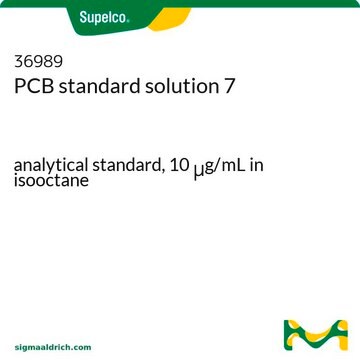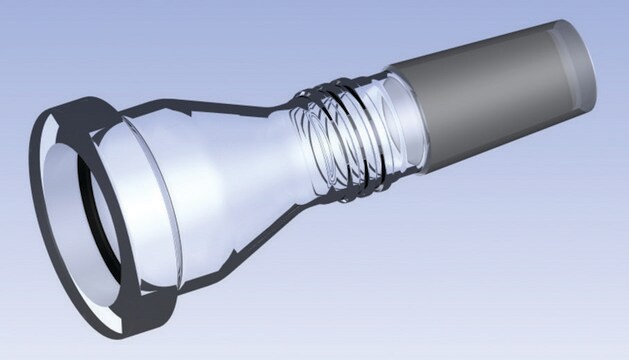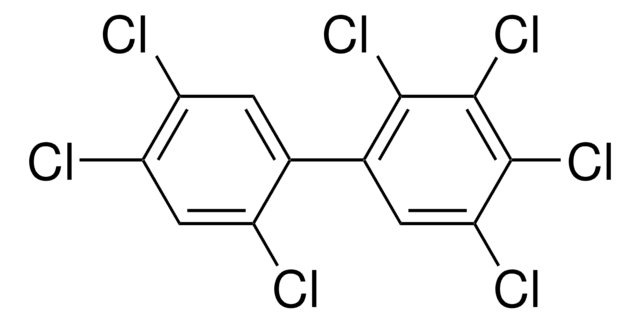BCR289
2,4′-Dichlorobiphenyl
BCR®, certified reference material
Faça loginpara ver os preços organizacionais e de contrato
About This Item
Fórmula empírica (Notação de Hill):
C12H8Cl2
Número CAS:
Peso molecular:
223.10
Beilstein:
1946417
Número MDL:
Código UNSPSC:
41116107
ID de substância PubChem:
NACRES:
NA.24
Produtos recomendados
grau
certified reference material
Agency
BCR®
fabricante/nome comercial
JRC
formato
neat
temperatura de armazenamento
2-8°C
cadeia de caracteres SMILES
Clc1ccc(cc1)-c2ccccc2Cl
InChI
1S/C12H8Cl2/c13-10-7-5-9(6-8-10)11-3-1-2-4-12(11)14/h1-8H
chave InChI
UFNIBRDIUNVOMX-UHFFFAOYSA-N
Categorias relacionadas
Descrição geral
2,4′-Dichlorobiphenyl is a polychlorinated biphenyl (PCB) congener whose biphenyl nucleus is substituted with two chlorine atoms. PCBs are well-known environmental contaminants and are classified as persistent organic pollutants.
Aplicação
2,4′-Dichlorobiphenyl may be used as a certified reference material (CRM) to quantify the analyte in environmental samples by chromatography techniques.(3)(4)
Nota de análise
For more information please see:
BCR289
BCR289
Informações legais
BCR is a registered trademark of European Commission
Palavra indicadora
Warning
Frases de perigo
Declarações de precaução
Classificações de perigo
Aquatic Acute 1 - Aquatic Chronic 1 - STOT RE 2
Código de classe de armazenamento
11 - Combustible Solids
Classe de risco de água (WGK)
WGK 3
Ponto de fulgor (°F)
Not applicable
Ponto de fulgor (°C)
Not applicable
Choose from one of the most recent versions:
Certificados de análise (COA)
Lot/Batch Number
Sorry, we don't have COAs for this product available online at this time.
If you need assistance, please contact Atendimento ao cliente
Já possui este produto?
Encontre a documentação dos produtos que você adquiriu recentemente na biblioteca de documentos.
Robert M Burgess et al.
Environmental toxicology and chemistry, 23(11), 2534-2544 (2004-11-24)
Recent studies demonstrate that sedimentary black carbon (BC) affects the sorption of some hydrophobic organic contaminants (HOCs) to a greater extent than sedimentary organic carbon (OC). Among HOC, polycyclic aromatic hydrocarbons (PAHs) are known to interact extensively with BC. Currently
Qi Lin et al.
Ying yong sheng tai xue bao = The journal of applied ecology, 16(4), 688-692 (2005-07-14)
To understand the surface chemistry of phenolic pollutants in the presence of metal oxides, this paper studied the reactions of 2,4-dichlorophenol with metal oxides in a kinetic and batch experiment. The results showed that amorphous ferric oxyhydroxide, goethite, delta-MnO2 and
Wenjie Ren et al.
Environmental science and pollution research international, 25(20), 20084-20096 (2018-05-12)
Graphene may affect fate of organic contaminants due to its strong adsorption properties, which is very crucial for accurately assessing ecological risk of graphene and concurrent contaminants, while the current information remains largely unknown. Here, we firstly explored the adsorption
D L Busbee et al.
Archives of toxicology, 68(2), 96-102 (1994-01-01)
Absorption from the gastrointestinal tract and subsequent vascular transport of [3H]-2,4'-dichlorobiphenyl (Aroclor 1232; DCB) was investigated in an ovine model system. Rapid uptake of DCB and transport as a component of blood plasma without prior occurrence in thoracic duct lymph
QSPR models for polychlorinated biphenyls: n-Octanol/water partition coefficient
Padmanabhan J, et al.
Bioorganic & Medicinal Chemistry, 14(4), 1021-1028 (2006)
Nossa equipe de cientistas tem experiência em todas as áreas de pesquisa, incluindo Life Sciences, ciência de materiais, síntese química, cromatografia, química analítica e muitas outras.
Entre em contato com a assistência técnica










